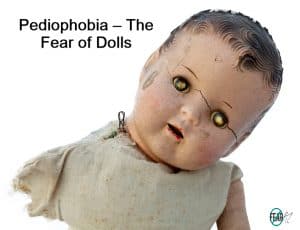Share This Article
Excessive Fear of Dolls Not Child’s Play
Ever walked into a room then bolted right back out because you saw a doll? Before you visit your grandmother, does she hide her doll collection because of your fear of dolls? Do you freeze in front of toy stores and imagine all the dolls tearing free of their packaging and marching towards you?
For you, dolls aren’t fun—they’re horrifying. How could they be anything less after watching Annabelle or Chucky in Child’s Play?
If merely reading those infamous dolls’ names sends shivers snaking up your spine, you may have an excessive fear of dolls. Do you ever worry that a crazed doll is right behind you? Do evil-doll nightmares plague you when you crawl into bed? If so, then you might have pediophobia, or a phobia of dolls.
What Is Pediophobia?
Pediophobia means the fear of dolls. It is categorized as a ‘specific phobia.’ It fits under automatonophobia, which is the fear of humanoid figures. This phobia includes people who are afraid of all dolls and stuffed toys or those who only fear only a specific doll type. It also includes individuals who are fearful of realist objects like puppets, wax figures, and animatronics. While inanimate dolls don’t represent a threat, most pediophobes are terrified of dolls that talk or move. Old-fashioned china dolls are also triggers of this phobia because of their likeness to humans.
Pediophobia is an anxiety disorder that, if not treated, continues on from childhood into adulthood.

What Causes Pediophobia?
Fear often stems from real threats, but it can also originate from perceived dangers. If the sight of a doll gives you goosebumps, then you aren’t alone. Think of the several popular movies and television series, or shows that feature children’s toys. Most of these toys are portrayed as vessels for evil spirits. No wonder so many of us shudder at the sight of dolls.
But what if you’ve never watched these horror flicks and still have a fear of dolls? Studies have shown that most fears are learned behaviors. That means that the phobic has had no terrifying encounter with the object or situation that triggers fear. Perhaps you developed pediophobia, because someone in your family had an extreme reaction to dolls.
Ventriloquist dolls, or dummies, as they’re called, are another source of fear for many. Some individuals suffer from a fear of this style of doll because of their bulging eyes and more human-like appearance. This phobia may not develop due to any past trauma or experiences—it’s just appearance and likeness that feeds the fear.
What Are Pediophobia Symptoms?
For people with a phobia of dolls, seeing or thinking about dolls may cause the following symptoms:
Physical Symptoms
- Chest pain
- Sweating
- Breathing difficulty
- Elevated heart rate
- Nausea
- Dry mouth
- Feeling choked
- Screaming or crying
- Trembling or shivering
Psychological Symptoms
- Panic attacks
- Scary dreams involving dolls
- Mental distress causing aggression or violence
What Self-help Methods Can You Use?
Are you wondering how to overcome the fear of dolls? If your fear is not extreme, you may be able to contain it with proven self-help methods. The next time you freeze in front of a toy store, for instance, tell yourself you are not in danger and that the dolls inside are just toys. Visualize walking past the store and then take one step at a time until you’ve passed the shop.
Eventually, you’ll replace the mind-numbing fear and panic with a less severe reaction like dismay, unease, or a slight dread.
Here are a few more steps that you can take to help with the fear you feel should you encounter a doll:
Social Support
Having someone to talk to always helps. Your friend can even hold your hand while you walk past a toy store, for example. That could help you manage your fear.
Mindfulness
While you cannot always determine when certain emotions will overwhelm you, practicing mindfulness can help you manage them.
Stress Management Techniques
Proven methods or techniques such as deep breathing, muscle relaxation, and visualization can also aid in your ability to handle a stressful encounter.
Put Your Health First
Eating well, resting enough, and regular exercise has benefits beyond endowing us with lean or muscled bodies. These are crucial for a healthy mind, as well.
What Professional Help Can You Get?
Phobias are known to debilitate people if they are not dealt with. Avoidance is a band-aid approach. It is not a solution. Even if dolls do not appear in your daily life and you stop going to malls with toy stores, you may find yourself obsessively thinking and worrying about dolls and how to avoid them. When fear interferes with your life to such an extent, it’s time to get pediophobia treatment.
Phobias and excessive fear are treatable. The following therapies have shown high success rates for all kinds of phobias, including pediophobia.
Psychotherapy
Talking to a psychologist or psychiatrist and discussing your phobia can help you identify what caused it and how it reached such an intense, crippling stage. Over time, counseling will help restore your sense of control over your feelings, reactions, and behavior.
Cognitive Behavioral Therapy (CBT)
Cognitive Behavioral Therapy (CBT) techniques have worked wonders with people who have phobias. Trained therapists work side-by-side with patients to help them confront their fears. One of the best ways to change behaviors towards objects that trigger fear is to replace negative thoughts with positive ones. You’ll also learn relaxation techniques, and with some practice, you’ll use them with greater success each time your anxiety flares.
Systematic Desensitization
In this form of therapy, patients are gradually exposed to objects they fear, in this case, dolls. Such exposure in a safe environment will help raise your tolerance levels and give you opportunities to practice your new skills.
If your phobia is severe, your therapist may suggest medications in parallel with your therapy. Once your fear reaches a more manageable level, you can begin to work through it and regain control of your life.
Family Therapies
In this form of therapy, counseling is provided for the family members of the patient. Very light exercises and therapies that can be implemented at home are taught to parents, along with tips on dealing with a child’s fears.
Virtual Therapies
This therapy method involves using virtual reality techniques to facilitate interaction between a patient and dolls. This is considered the most modern way of treating phobias.
What Else Can You Do to Handle Pediophobia?
Are you still wondering how to overcome pediophobia? When you challenge your fears, the stress you feel while handling it the next time will decrease. This is why it’s advisable to face your fear rather than hide from it.
Be curious about your fears. Try to examine what scares you and why. By looking at fear as a thing to explore instead of as trauma, you might change your perception of it, and your reaction to it.
Adopt meditation as a daily routine. Sit calmly with your eyes closed, and try to sense your surroundings. This will also help you control your mind when your fear is triggered.
Similar Phobia: Pupaphobia-The Fear of Puppets
Bottom Line
Pediophobia is not merely a general creepy feeling when you encounter a doll. It’s a persistent, excessive, and significantly distressing fear of dolls phobia. But you can be free of it. You can regain control of your life. Just reach out for readily available help, and you’ll have taken your first step toward recovery.




